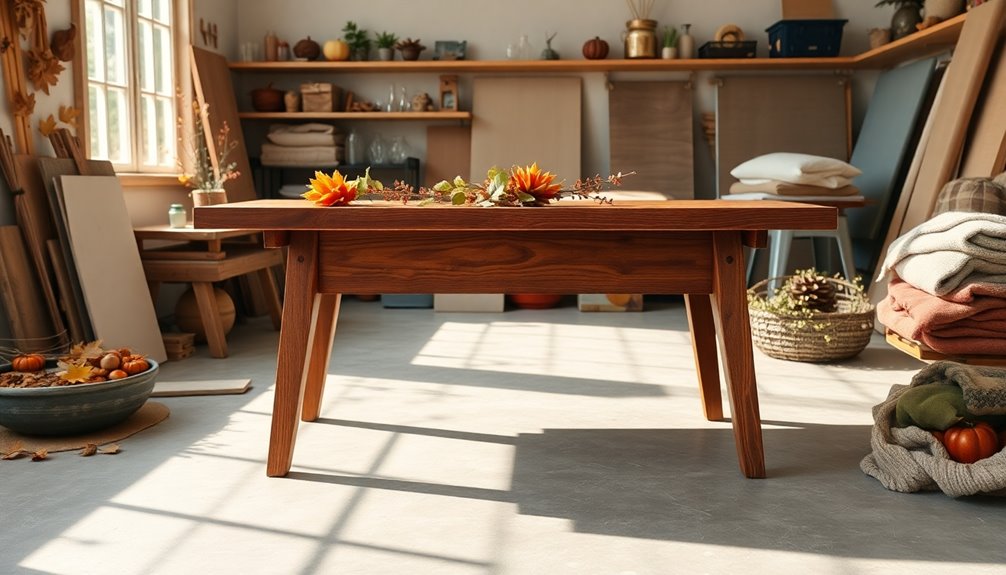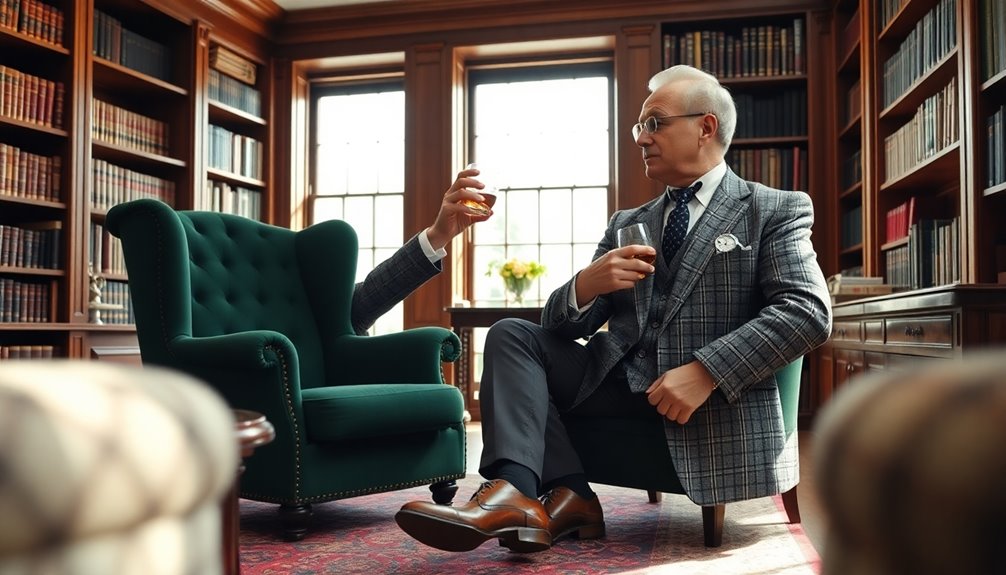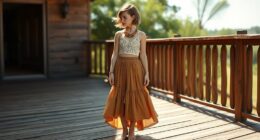To make a stylish sofa table, start by gathering your materials: wood, screws, and finish of your choice. Cut the wood to your desired dimensions for the top and legs. Assemble the legs securely using screws, checking for stability. Sand the edges to avoid splinters and apply your preferred stain or paint for a polished look. Consider using UV-resistant finishes to prevent fading when placed near sunlight. Finally, rotate decorative elements seasonally for a fresh touch. There’s plenty more to explore, like hardware checks and personalized techniques to elevate your sofa table further. Once your stylish sofa table is complete, you can enhance its functionality by considering arranging living room furniture tips that complement its design. Think about the flow of the room and how the table interacts with other elements, such as seating and lighting. Adding decorative items like vases, books, or candles can personalize the space, while ensuring each piece works harmoniously together to create a cohesive atmosphere.
Key Takeaways
- Choose a sturdy material like wood or metal for the table frame and surface to ensure durability and stability.
- Measure the desired dimensions for the sofa table, considering the height and length to fit your space properly.
- Assemble the frame using screws or wood glue, ensuring all joints are secure to maintain structural integrity.
- Finish the table with paint, stain, or a protective sealant to enhance appearance and protect against wear.
- Add decorative elements like drapes or seasonal decor to personalize the sofa table and match your living space aesthetic.
Introduction

When you're making a sofa table, it's just as important to think about keeping it clean as it is to build it. Regular vacuuming and dusting will help maintain its appearance, while knowing the right cleaning techniques for different fabrics can prevent damage. Plus, if you ever face a red wine spill, having a plan in place can save your beautiful table from permanent stains.
Routine Vacuuming and Dusting
To keep your sofa table looking its best, routine vacuuming and dusting are essential. Regular vacuuming helps remove dust and debris that can accumulate and detract from your table's appearance and hygiene. Use a vacuum with a soft brush attachment to gently clean the surface without scratching or damaging the finish. This simple step keeps your table looking polished and inviting.
Dusting should be done at least once a week. Focus on the edges, corners, and any decorative items that adorn your table. A microfiber cloth is your best friend here, as it effectively traps dust particles without sending them back into the air. When you dust, be sure to remove any decorative items first; this prevents dust buildup on both the table and the items themselves. Clean these decorative pieces separately to maintain their shine and clarity. Additionally, using a vacuum with strong suction can enhance your cleaning routine by ensuring a more thorough removal of dust and allergens.
Fabric-Specific Cleaning Techniques
Keeping your sofa table clean extends beyond routine vacuuming and dusting; it also involves understanding the specific cleaning needs of the fabrics involved. Different upholstery fabrics require different cleaning techniques. For instance, microfiber can be easily cleaned with a damp cloth, while cotton may need machine washing or spot cleaning. Always check the care label on the fabric for recommended cleaning methods and any restrictions.
For delicate fabrics like velvet, you'll want to use a soft brush to gently remove dust. Avoid water-based cleaners, as they can damage the fabric's texture. When it comes to stain treatment, act quickly! Use a blotting technique instead of rubbing, which can spread the stain or harm the fibers.
Some materials, like leather, need special cleaners and conditioners to keep them looking great and prevent cracking. Others may only require a mild soap solution. By tailoring your cleaning techniques to your specific fabrics, you'll ensure your sofa table looks its best for years to come. Understanding these specifics can save you time and headache down the line, keeping your furniture in prime condition. Additionally, maintaining a clean environment can enhance air quality and contribute to your overall health and well-being.
Tackling Red Wine Spills
A red wine spill can turn a cozy evening into a cleaning nightmare if you don't act quickly. First, grab a clean, dry cloth and blot the spill immediately. This step is crucial for absorbing as much wine as possible without rubbing it deeper into the wood or fabric. For wooden surfaces, mix a mild dish soap with warm water, dampen a cloth with the solution, and gently wipe the affected area. Rinse with a clean, damp cloth afterward to remove any soap residue.
If the stain is on fabric upholstery, sprinkle baking soda over the affected area. This will absorb moisture; let it sit for about 15 minutes before vacuuming it up. Afterward, you can apply a suitable fabric cleaner. Always remember to test any cleaning solution on a small, inconspicuous area first to avoid damaging your DIY project.
If the stain persists, consider using a specialized stain remover or reach out to a professional cleaner for advice. Dealing with red wine spills promptly can save your table and keep your home looking pristine.
Avoiding Direct Sunlight Exposure

To protect your sofa table from sunlight damage, consider using scratch-resistant fabrics and decorative drapes. These options not only shield the wood from harmful UV rays but also add a stylish touch to your decor. Additionally, using protective furniture covers can further safeguard your table when it's not in use.
Using Scratch-Resistant Fabrics
When it comes to choosing fabrics for your sofa table, opting for scratch-resistant materials is essential for maintaining its appearance and longevity. Look for scratch-resistant fabrics like microfiber or performance fabrics that can withstand everyday wear and tear. Fabrics with a tight weave and durable fibers, such as polyester or nylon blends, offer increased resistance to scratches and fading.
In addition to selecting the right fabric, be mindful of the sofa table's placement. Avoid putting it in direct sunlight, as prolonged exposure can cause colors to fade and weaken the fabric over time. To further protect your fabric, consider applying a UV-protective spray or coating. This can enhance its resistance to sun damage, keeping the colors vibrant and the material strong.
Regularly rotating decorative items on the table can also help maintain the fabric's overall condition. By changing the arrangement, you prevent uneven wear on the surface, ensuring that it remains looking fresh. Investing time in selecting the right scratch-resistant fabrics and taking preventive measures will keep your sofa table in excellent shape for years to come.
Decorative Fabric Drapes
During the day, decorative fabric drapes can be a stylish solution to shield your sofa table from harmful sunlight. Opt for drapes made from UV-resistant materials to effectively block out those rays while enhancing your living room's aesthetic. To create a warm ambiance, ensure they're lined with a light-filtering fabric. This way, you can soften the incoming light without completely darkening the room.
When selecting colors or patterns, choose options that complement your living space decor. This adds both functionality and flair to your DIY sofa table setup. Hang the drapes on adjustable curtain rods, allowing you to easily modify their position based on the time of day and the angle of sunlight exposure.
Incorporating energy-efficient designs can also help maintain a comfortable temperature in your living space, reducing reliance on heating and cooling systems. Don't forget to regularly clean and maintain your decorative fabric drapes. Dust accumulation and fading can diminish their effectiveness and beauty over time, so it's wise to keep them in top shape. By incorporating these drapes into your living room, you can protect your sofa table while adding an elegant touch to your space.
Using Protective Furniture Covers
A protective furniture cover is essential for safeguarding your sofa table from harmful direct sunlight. Exposure to direct sunlight can significantly fade your wood finishes and even lead to warping over time. By using protective furniture covers, you block these damaging UV rays, ensuring your table retains its beauty and structural integrity.
When selecting a cover, opt for UV-resistant and waterproof options. These materials not only shield against sunlight but also prevent moisture buildup, reducing the risk of mold and mildew. Many high-quality covers are made from breathable fabrics, allowing airflow while keeping dust, spills, and scratches at bay.
It's crucial to regularly remove and clean your covers to prevent dust and allergens from accumulating, promoting a healthier living space. Maintenance is simple: just wash the covers according to the manufacturer's guidelines, and your sofa table will remain in excellent condition.
Incorporating protective furniture covers into your home decor routine is a smart investment. Not only do they extend the lifespan of your furniture, but they also enhance the overall aesthetic of your living space.
Routine Hardware Checks

When it comes to maintaining your sofa table, routine hardware checks are essential. You should frequently inspect loose joints and connections to ensure everything stays sturdy and secure. Additionally, don't forget to condition any leather components and fluff the cushions to keep your table looking and functioning its best.
Loose Joints and Connections
Loose joints and connections can compromise the stability of your sofa table, so it's essential to perform routine hardware checks. Start by regularly inspecting all screws and joints every few months. Tighten any loose screws you find, especially where the tabletop connects to the legs and any supporting structures. Use a screwdriver to ensure everything is secure and stable.
If you notice any joints separating, apply wood glue to reinforce them. Make sure to let it dry completely before reassembling to ensure added strength. Wood filler can also be a lifesaver for repairing damaged areas or holes caused by loose hardware. Smooth it out for a clean finish to prevent future issues.
Don't forget to check the condition of your corner brackets and fasteners. Replace any that show signs of wear or rust, as these can significantly impact the overall integrity of your table. By staying on top of these routine checks, you'll keep your sofa table sturdy and looking great, ready to hold your favorite decor or snacks without worry.
Leather Conditioning Techniques
How often do you check the condition of your leather surfaces? Regular inspections are crucial to spot any signs of dryness, cracking, or discoloration that indicate it's time for conditioning treatments. To maintain suppleness and prevent deterioration, you should use a high-quality leather conditioner every 6–12 months. Always follow the product instructions for the best results.
Before applying conditioner, make sure to clean leather surfaces with a damp cloth and a gentle leather cleaner. This step removes dirt and oils, promoting better absorption of the conditioner. Additionally, it's wise to test any new conditioning product on a small, inconspicuous area first to ensure compatibility with your leather.
Keep in mind that storing leather items away from direct sunlight and heat sources can significantly reduce the risk of fading and drying out. By taking these steps, you'll not only maintain the beauty of your leather surfaces but also extend their lifespan. Regularly checking for signs of dryness and conditioning when needed will keep your leather looking its best and feeling supple for years to come.
Regularly Fluffing Cushions
Maintaining the comfort and longevity of your sofa hinges on the simple yet effective practice of regularly fluffing cushions. By doing this at least once a week, you'll keep cushions from becoming flat or misshapen, ensuring a comfortable seating experience. Pay close attention to any signs of wear or sagging, as these may indicate that your cushions need replacement or additional support.
While fluffing, check for loose seams or fabric pulls—addressing these issues promptly can prevent further damage. Consider implementing a routine of rotating and flipping cushions periodically to distribute wear evenly. This practice helps maintain a uniform appearance and prolongs the life of your upholstery.
If you've placed a sofa table turned behind the couch, make sure it doesn't obstruct your cushion care routine. You might even find that pieces of wood or other decorative items need rearranging for easy access. Regularly fluffing your cushions not only enhances comfort but also provides those finishing touches that keep your living space looking its best. With these habits in place, your sofa will stay inviting and beautiful for years to come.
Personalized Staining Techniques

Personalizing the staining of your sofa table can elevate its appearance and reflect your unique style. To achieve a rich finish, start by cleaning the wood with denatured alcohol. This step removes any dust and oils, ensuring better stain adhesion. Once the surface is clean, you can apply the stain. For a deep, luxurious color, opt for Minwax Dark Walnut and apply it in two coats. Allow the stain to dry for at least 8 hours between applications to maximize color depth.
When you're ready to apply the stain, use a sponge brush or cloth, following the wood grain to avoid streaks and achieve a uniform look. After the final coat of stain has dried, consider finishing your table with a coat of triple-thick polyurethane for added durability. Each coat of polyurethane should also dry for 6-12 hours before adding another layer.
Before committing to the entire surface, test the stain on a small, inconspicuous area to ensure you're happy with the color. This way, you can create a personalized finish that truly reflects your style and enhances your sofa table's beauty.
Seasonal Furniture Rotation Tips

After you've perfected the stain on your sofa table, consider giving it a fresh look by rotating seasonal decor. This practice not only refreshes your space but also aligns with mood changes throughout the year. For instance, keep lighter, summer-inspired decor on your table and switch to cozy, warmer pieces as fall and winter approach.
To maintain functionality, opt for seasonal items that serve a purpose, like candles or seasonal flowers, which can be easily interchanged. Regularly assess the wear and tear on your furniture builds. If you notice any damage, don't hesitate to make repairs or refinishing to ensure your table looks its best year-round.
Creating a designated storage space for your seasonal decor simplifies the rotation process. When you have all your items organized, it makes switching out decor as the seasons change much easier. Keep your storage area tidy and accessible so you can quickly refresh your sofa table with each new season, enhancing your home's aesthetic and keeping your space inviting. Embrace the transformation with each seasonal decor swap, and enjoy the evolving atmosphere in your home. Additionally, incorporating mindful decluttering practices can help maintain a serene environment as you rotate your decor.
Conclusion

Creating a sofa table is not just about aesthetics; it's about enhancing the functionality and style of your living space. With the right design and materials, you can create a practical piece that serves multiple purposes, like providing space for drinks, decor, and even charging devices. Aim for dimensions that complement your couch, typically around 5.5 feet long and 30 inches tall, to ensure a seamless look.
When building your table, consider using sturdy materials like 1×8 or 2×12 used pine boards. This choice not only promotes durability but also allows for a stylish finish. Don't forget to incorporate features like recessed power strips for added convenience. Proper assembly techniques, such as using a pocket hole jig, are crucial for achieving a stable and lasting table.
Finally, finishing touches like sanding, staining, and applying polyurethane can elevate your table's aesthetics while protecting it from wear and tear. By keeping these tips in mind, you'll not only create a beautiful sofa table but also one that enhances your living space's functionality for years to come. Enjoy your new creation!
Frequently Asked Questions
What Is the Correct Size for a Sofa Table?
When determining the correct size for a sofa table, aim for a height of about 30 inches, which matches most sofa seat heights. Your table should ideally be between 60 to 72 inches long to fit comfortably behind your sofa. For depth, stick to 12 to 18 inches to avoid cluttering your space. Finally, make sure it's 2 to 4 inches shorter than your sofa's back for a balanced look.
Is There a Difference Between a Sofa Table and a Console Table?
Yes, there's definitely a difference between a sofa table and a console table. A sofa table's designed to sit behind your sofa, usually narrower and lower, while a console table can fit in various spaces around your home. Sofa tables are often used for decorative items or drinks, whereas console tables might store items or display artwork. So, think about your space and needs when deciding which one fits best!
What Wood to Use for a Sofa Table?
When choosing wood for your sofa table, consider your style and needs. Pine's affordability and ease of use make it a popular choice for DIYers. If you prefer a refined look, opt for poplar with its smooth grain. For a classic aesthetic, oak offers durability and rich color. If you want something unique, reclaimed wood adds character but requires extra prep. Lastly, MDF is economical but not ideal for damp areas.
What Are the Rules for Sofa Table Design?
When designing a sofa table, you should keep a few key rules in mind. First, aim for a height between 28 to 36 inches to match your sofa's height. Next, choose a length that's either equal to or slightly shorter than your sofa for balance. Keep the depth between 12 to 18 inches for functionality. Lastly, ensure the style matches your room's decor, enhancing the overall aesthetic while considering any functional features you might need.









